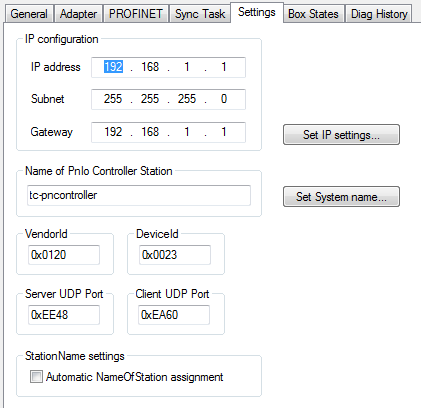PROFINET controller-specific settings
Settings that directly concern the controller can made on the ‘Settings’ tab.

An IP setting can take place here. The selection of the address range need not correspond to the network card settings. The PROFINET communication spreads its own net, which can be selected here. The IP settings shown in the above illustration are the default settings, i.e. if nothing is changed the controller uses these settings. The same applies to the controller name (system name). The corresponding button must be pressed to change either of these two settings. A check is made to ascertain that the input is correct (e.g. the format of the controller name must correspond to the PN spec.). These data are then permanently adopted. If the subnet or gateway is changed, the settings will also be adopted by possible projected devices. There is also a possibility to modify these settings via a supervisor tool.
In addition the VendorID and DeviceID of the controller can be read out in this dialogue. The server and client UDP port employed can also be set here. The default settings should, however, be adequate in most cases.
Furthermore there is a possibility in this dialogue to enable an automatic PROFINET start-up following a device exchange (including devices without removable media). For correct functioning the nominal topology must be specified once. On the basis of this information the controller can query the alias names of the individual devices. Every device that supports alias names generates such a name for each of its ports. This is composed of the neighborhood IDs (PortId.ChassisId). If this name is queried, the ‘new’ device answers. If VendorId and DeviceId are correct the device is named with the actual name and a normal PROFINET start-up can subsequently take place. With this mechanism a complete PROFINET system could also start up without having named an individual device beforehand.